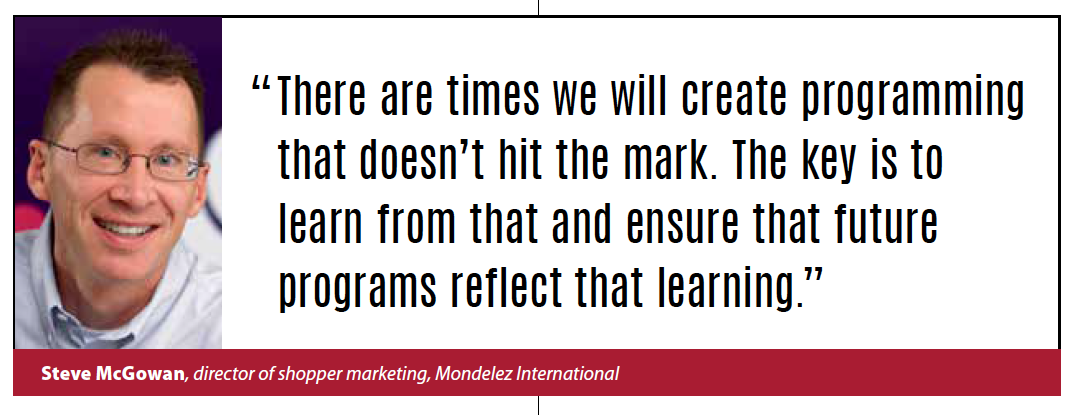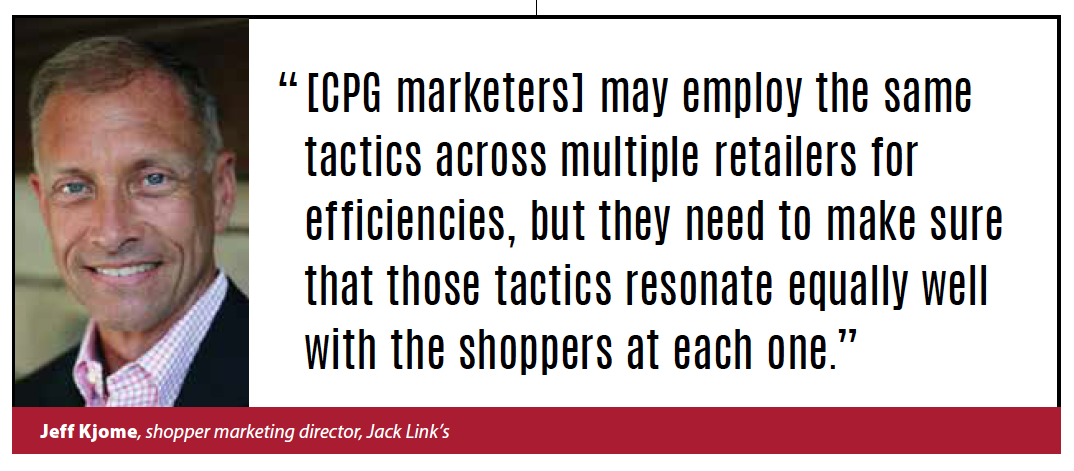Working with Retailers
For all the power that retailers seem to hold from a CPG manufacturer’s perspective, they are struggling to hold steady in a highly disruptive marketplace. Arguably, CPG channels are floundering less than other retailers, but they face formidable threats ranging from Amazon’s omnipresence to Aldi’s price-war ignition. As Bloomberg reported March 30, Amazon’s “audacious bid” to persuade CPG manufacturers to ship directly to online shoppers and bypass chains altogether may eventually “upend relationships” between brands and traditional CPG channels.
In the meantime, however, retailers view relations with CPG marketers as “more strategic and less transactional,” says Patrick Fitzmaurice, managing director of professional development at the Path to Purchase Institute. “They seek a true partnership.”
In this article, two retail marketers, speaking on condition of anonymity, tell us what their CPG partners could do to strengthen brand-retailer relations. Additionally, CPG marketers do some self-reflecting to assess where brands succeed and fall short, and third-party experts weigh in with their perspective.

Shifts in power
The power imbalance between retailers and CPG suppliers stems partly from the former’s increasing size and concentration, and a tendency to throw their weight around. “Larger (newly merged) companies go into negotiations with vendors knowing they have the upper hand,” says a partnership marketing director for an international retailer whom we’ll call Bob. “The perception is that there’s a lot of room for retailers to gain more margin.” (Case in point: Reuters reported in February that Walmart is running price-comparison tests and “squeezing packaged goods suppliers in a bid to close a pricing gap” with discount players like Aldi.)
Other factors besides size and scale skew power to the retail side. Retailers have become powerful brands in their own right. “Shoppers have come to associate a particular brand promise and experience with certain retailers, so CPG brands, by and large, don’t have as much clout,” says Jovina Young, channel-solutions director and senior marketing manager at MillerCoors.
Neither retailers nor CPG brands wield as much power as today’s shopper, Fitzmaurice says. “This means that the two of them need to start playing nicer together. The only way to capture growth in the marketplace is to think about the shopper first.”
This joint goal forms the basis of a win-win relationship.
Different stores, different shoppers
“A common mistake is not taking into account shopper differences across retailers,” says Jeff Kjome, shopper marketing director at Jack Link’s. “A given tactic may work very well at Retailer X, but the shopper at Retailer Y might be completely different.”
To work well with retailers, CPG marketers must understand their core shopper as well as each banner’s brand and business mode. Only then can brands and retailers deliver on the shopper’s expectation of personalization through an omnichannel experience. Once marketers truly understand each retailer and its shopper, it becomes clear that offering them the same products and programs won’t work and that consumer insights don’t apply across the board.
Retailers want CPG partners to bring them exclusive programs, unique product packs, curated assortments and special asset allocations such as media investment.
“What seems to work is when CPG ideas are ownable by (the retailer) – something we can put our stamp on, something that folds into our objectives, fits our schedule and programs, and appeals to our shopper,” Bob says. “What we don’t want is something canned, cookie-cutter or brand-centric.”
While many CPG marketers grasp the importance of meeting the needs of a specific retailer’s shopper, “there are times we will create programming that doesn’t hit the mark,” says Steve McGowan, director of shopper marketing at Mondelez International. “The key is to learn from the program and ensure that future programs reflect that learning.”
Another common mistake CPG marketers make is “focusing planning discussions on how their brand will get increased lift from a specific initiative,” Young says. “If a shopper marketing initiative simply involves stealing share from another brand and doesn’t drive overall category growth, you’re only catering to your own needs.”
That doesn’t fly with retailers. “The pithy way to put it is: It’s not about you,” Fitzmaurice says. “If you come in talking only about your brand’s goals and direction, you’re not having the type of relationship and discussion retailers want.”
On the other hand, if the CPG marketer comes in with “a rising-tide-lifts-all-ships mentality and solutions that help the overall category win, then they are effective partners that retailers will want to work with again and again,” says Matt Silvestri, a group account director at The Integer Group who works with Walmart and Sam’s Club.
Finding alignment and fitting in
Once CPG marketers thoroughly understand retail partners and their shoppers, they can deepen the relationship by identifying strategy alignments and opportunities to participate in retailer-led initiatives. “For retailers, it is very important for CPG brands to fit within their existing plans since the retailer is planning for the entire category, not just an individual brand,” Silvestri says.
Many retailers hold annual vendor fairs or summits to share their plans, priorities and event calendars with CPG partners. “It’s helpful when vendors step up, commit early and get on board to bring our important events to life,” says a regional retail chain’s director of customer loyalty and shopper marketing whom we’ll call John. “If CPGs play hard at banner-led opportunities, we will be more receptive to their program ideas."
As CPG marketers are well aware, a retailer’s calendars and plans are subject to change on short notice due to “hypersensitivity to sales figures week by week,” Bob says. “Decisions are driven by a ‘win the week’ mindset.”
Therefore, brands must be “flexible and nimble when working with retailers, as change is constant within the retail environment and the speed of retail itself can be challenging,” Silvestri says.
Best Practices
An ideal brand-retailer relationship is “highly collaborative, highly adaptable and accountable on both sides,” McGowan says. “We need to hold each other accountable for our commitments while being adaptable to changing market trends.”
The criteria for the Kantar Retail PoweRankings are the building blocks of an ideal relationship. “What makes retailers give manufacturers high marks is a clearly articulated strategy, grounded in shopper insights, that demonstrates an understanding of the retailer’s objectives,” Fitzmaurice says.
While retailers appreciate the national picture and consumer insights, “manufacturers that only present broad insights aren’t demonstrating that they’re in touch with the retailer’s specific priorities,” Kjome says.
Presenting initiatives that “clearly incorporate a retailer’s insights and priorities into the plans is a critical best practice,” he adds.
Many retailers share or sell shopper data and program analytics to CPG companies, and “we like to see CPGs use that data to better inform them on how to work with us,” John says.
Another best practice Kjome counts as critical is “establishing check-ins after program completion in order to share results, get retailer input and agree on learnings to apply to future programs.”
To recap, best practices for brand-retailer relations include:
- Developing a long-term vision for the brand category as a whole.
- Bringing insights and initiatives that support each retailer’s agenda.
- Using key performance metrics to measure success as defined by both parties.
The whole package
“I think an ideal relationship would be when a retailer and a manufacturer can get together, talk through a business challenge and develop a solution that works for both groups,” Kjome says. “On the retailer side, that could be something like increasing foot traffic, building trip frequency or retaining shoppers both online and in-store. For manufacturers, it could be getting a new product off to a strong start or ensuring a brand is available in relevant places throughout the store.”
It takes a village comprising multiple disciplines from both sides – and, sometimes, multiple CPG manufacturers and retail buyers – to develop and execute insight-based programs pegged to each retailer’s banners and shopper, says Greg Pukas, senior director of global sales effectiveness and revenue management at Pfizer.
“Shopper solutions” programs that bring together all the ingredients to make s’mores, for example, or the items necessary for a tailgate party require “high-order collaboration and a joint goal,” Fitzmaurice says.
CPG marketers “may employ the same tactics across multiple retailers for efficiencies, but they need to make sure that those tactics resonate equally well with the shoppers at each one,” Kjome says.
An example would be Pfizer’s pain relief program combining Advil and ThermaCare heatwraps. “The program was brought to life differently at each retailer,” Pukas says, with store displays featuring professional moms at Target, blue-collar workers at dollar stores, and gardeners and broader lifestyle messaging at CVS. Yet all executions were based “on the same broad consumer insight that consumers consider pain relief as a process and they layer solutions to get relief.”
Conclusion
Wise – and realistic – CPG manufacturers and retailers recognize their codependence and intertwined destinies, and they work to establish more open, collaborative, trust-based and results-oriented partnerships than they’ve had in the past. In a true partnership, each party benefits from the exchange of insights and post-program analytics that build “a better understanding of shopper behavior and the types of initiatives that build long-term growth for their respective brands and categories,” Kjome says. “The key is to create, evaluate and learn from our shopper marketing efforts together.”
